#my point of points is that of you have an interest in 90s doom shojo. these are. more than anything. high concept
Explore tagged Tumblr posts
Note
what are the 2 anime besides utena? do you recommend them?
that's angel sanctuary (top) and x (left). i think they're both historically important, but as for recommendation i'd say it depends!!
angel sanctuary (which has no anime to speak of, so this is all about the manga) is a Very Edgy Shojo. it features a lot of heavy subject matter significantly less tactfully handled than utena (the setup can be summarized as "guy who is the reincarnation of a female rebel angel doomed to eternal torment is in love with his sister" and it's really only downhill from there). it is, more than anything, a cathartic but crude and not very sensitive reading best experienced as a teen told not to read it, dealing primarily, messily, with gender, sexuality and lack of autonomy. i do not think it is without merit, but if you haven't read a kaori yuki manga before, i'd recommend starting with count cain&god child instead. if you're already fine reading something like the more recent requiem of the rose king, go for it.
x on the other hand, as most clamp manga, is readable on the strength of the craftsmanship and storytelling alone. it also deals with heavier subject matter, but i would say in a more restrained and mellow manner (mostly). the manga does not have an ending (and has been on "hiatus" since the early 2000s), but the madhouse anime does add some closure (i'd still recommend reading the manga but it's not the worst adaptation ever). it is imo, a bit less focused than some other clamp works, but it is also a solid read if you like a good apocalyptic tragedy focused on choices, human will & how it is impossible to know another person but also impossible to exists without being known (+ 90s environmentalism!). the prequel, tokyo babylon, is required reading for the full experience though, and that comes with it's own set of warnings (most glaringly, an age gap "romance" featuring a 16 year old protagonist).
4 notes
·
View notes
Photo
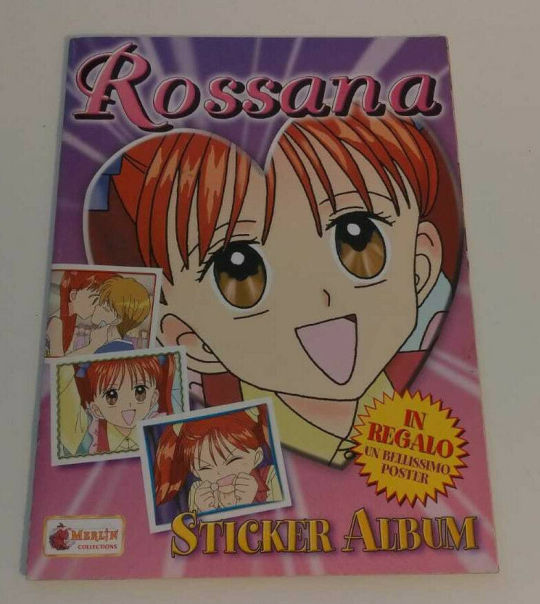


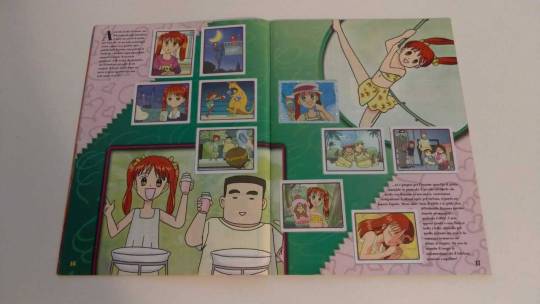

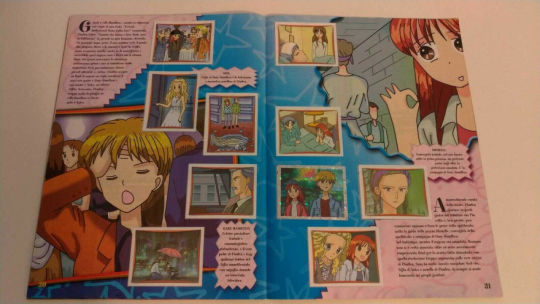
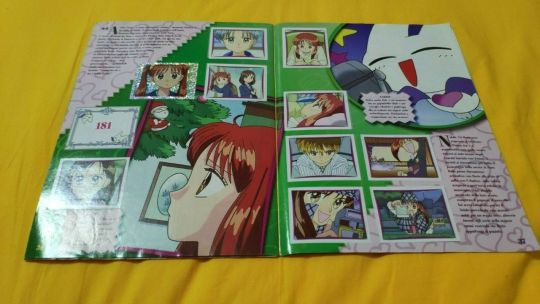
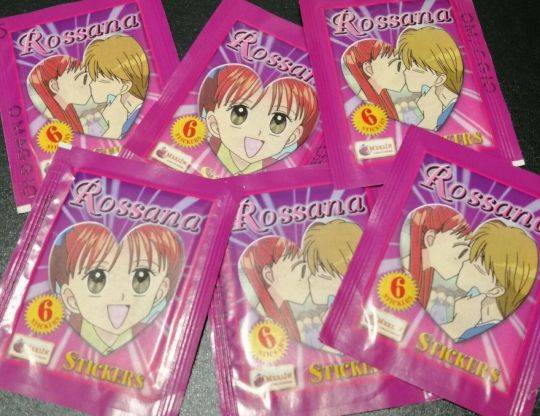
Kodomo No Omocha’s Sticker Album Highlights (Merlin, 2001, Italian)
Let's keep talking about retro japanese cartoons, shall we? I've done some posts lately in which I reviewed Game Boy games based on comics or animations from Japan, with the intention of covering series that I either used to watch as a kid or recall being popular during the GB and GBC eras. A lot of these games have never been released outside Japan, so it's also an occasion to gather up some imports and see what Italy has missed on. There's actually a particular cartoon I wanted to talk about since the start of this research, but unfortunately it seems it has never recieved any videogame adaptation. But hey, this is my blog, and I can talk about whatever I want! >:C Also I suddenly remembered my Fandom tag has been created purposely for non-gaming objects. >.> So, let's look at some stickers while I tell you the tale of Rossana.
Rossana can be best described as the soap opera that spawned a second wave of nipponic hysteria among every single italian person under 20 during the very last period of the 90s. It's like The Bold And The Beautiful looked at Pokèmon and said "yeah, I want something like that.". Its popularity hit even harder my personal view of the world as the plot starts with the protagonists attending the last year of elementary school... which is exactly what me and my friends were doing, multiplying the relatable factor tenfold. This cartoon took everyone by their necks since its first episode: it was broadcasted on what was, at the time, the best and most popular italian channel for children entertainment, and heavily advertised before starting, so we knew exactly when to tune in to catch it. The day after the first episode, school looked like a different place. Everyone in class was chanting the opening at the top of their lungs; boys were acting like the male protagonists, all girls mimicked the main role Rossana, the more artisticly inclined ones started doodling the characters anywhere possible, including textbooks and homework. Teachers were in tears. I had watched the first episode and found it amusing enough to keep me entertained, so for some period I fully partecipated in the general enjoyment of the cartoon. Then, I started missing episodes (when you missed something on TV during the 90s... it was gone!) and upon returning to it, I found the plot had become much more complex and centered on sentimental intrigues, of which I never gave a toss about, so I jumped off the hype train while others still followed it until the end.
As it is usual for these productions, Rossana was another anime based on a manga series; the original work is titled "Kodomo No Omocha" (which literally means "Children's Plaything"... yeah, I too find it a tad creepy), drawn by mangaka Miho Obana and serialized by Ribon from 1994 to 1998. It tells the story of Rossana Kurata, a child actress (an idol in the original story) trying to balance her career with a normal kid's life by going to school and having normal friends: however, her class is anything but normal and she finds herself often fighting against the biggest bully of the school group, Hayama (translated as Heric in italian). As the story progresses, though, Sana understands Heric's complex and at times completely inappropriate attitude is a result of a troubled childhood, having lost his mother at birth and being bullied by his older sister and completely ignored by his father. Willing to help him out, Sana befriends him and starts to develop even deeper feelings, also sharing her own troubled past: she had been actually abandoned as a newborn and adopted by Misako, a famous writer. New characters are introduced along the way, among which the child actor Charles, Sana's schoolmate but also colleague which the girl will work alongside during a trip to the States, and Funny, an extremely extroverted kid that will at first become close friends with Sana, but that will, at some point, steal Heric's heart, leaving Sana to deal with heartbreak and jealousy. Despite the story being drawn in an energetic shojo style and the episodes showing many hysterical/demential jokes along the way, Kodomo No Omocha is a dramatic story centered on overcoming past secrets, venomous feelings, and describing the difficult shift from childhood to adolescence.
The original 10 manga volumes got adapted for animation in 102 episodes, which broadcasted on TV Tokyo from 1996 to 1998. In Italy, the anime got imported first with the direct title "Rossana": it was aired in its entirety during all of the year 2000, and yes, all the 102 episodes got translated! Unfortunately, the channel wanted to make Rossana completely targetable to little kids, which meant that many plot elements had to undergo heavy censorship. The result was a comedy/demential series that at times showed a sentimental route, and for the rest felt very cut, like it was hiding something. This was no Chou Gals!-styled localizaion effort: scenes were edited or completely deleted, names and terms translated losing all context, graphics and objects concerning japanese culture got zoomed out, some episodes even aired randomly without following the original order, and finally the ending got cut, leaving it as an open cliffhanger. Kodomo No Omocha is, originally, marketed towards an adolescent audience, but kids are a much more profitable target, so a lot of the original plot points went away: Sana no longer thinks of Rei (her adult manager, called Robby in italian) as his boyfriend; it's never mentioned that her actual mother abandoned her in a park after giving birth at only 14 years old; and many instances in which some kids (Heric, but also Komori in later eps) practice self-harm or have suicidal thoughts are cut in their entirety. And yet, despite this general mangling, the story managed to become popular anyway, gaining three reruns, some video distribution on VHS and DVD (both cut, for unknown reasons, after the 20th episode), and an opening with lyrics that will never leave the minds of an entire generation. The manga got translated only after 2002, getting marketed instead for its actual audience and going for a literal translation of its original title: "Il giocattolo dei bambini - Rossana" got published by Dynit in its entirety, however I'm not sure wether it underwent the same censorship measures of the cartoon or it was left to a more faithful state.
The hype about Rossana was interestingly lacking of any substantial, original merchandise imported from their origin country; instead, every gadget we had about the anime was produced by italian companies and it consisted in the usual cheapish stuff sold in order to cash a quick buck on popular media. We had school supplies such as bags, pencil cases and diaries, decorated stationary, and the never-missing sticker album. This last merchandise, aptly featured in this post, is what I remember most since everyone was trading doubles at school; the blindingly hot pink package has also burned a permanent image in my mind. Published by Merlin in 2001, Rossana's abundantly pink album could contain 204 stickers; be them glossy, holographic, single or combined, it adds up as quite a large selection considering that all images shown were nothing more than screenshots of the cartoon, with album pages filling up a description of episodes shown, or giving a little more insight on the general plot. At least my previously reviewed Pokèmon album showed interesting action poses by Sugimori and doubled up as a Pokèdex, but I do recognize the latter can count on a much more substantial franchise. What Rossana's album excels in, though, is its value; remember when I said a completed Pokèmon album was only worth a few bucks? Well, a completed Rossana album goes instead for nothing less than a hundred euros on secondhand markets. Even the single stickers, if sold in lots, can become a pretty penny, and still sealed booster packs can range from 30 to 70 euros depending on how many you're selling. I can already picture italian readers going through their cupboards to see if they still have this relic intact! As for me, I was too focused on Pokèmon during that period to care about filling up another sticker album, so I had completely skipped that. And no, I'm not gonna spend 100+ euros on an album just to make a Fandom post: what you're seeing here are all images collectors have shown to the net.
It's interesting to notice that Merlin tried to cash in on the anime's popularity even beyond the sticker album itself, by advertising even among the album pages an upcoming periodical (monthly I suppose?) magazine almost all centered on the cartoon, but trying to double up as a typical girls' magazine with pictures of boybands, various articles, and the always present and equally emberassing mail section. For some reason I have very vivid flashbacks of me going through the pages of the first volume: probably some friend brought it at school, they had it lying about at their house, or I may have bought it along with other girls then left it to them. This mag was nothing particular and doomed to be shortlived: you can't keep a single anime series relevant forever, and it was apparent that arguments tried to always pull Rossana into context when in reality it had nothing to do with the articles. It seemingly disappeared after its second issue, and got buried under the sheer abundance of more relevant girly mags, among which the legendary Cioè.
All in all, Rossana’s shout of livelyhood was probably short, but loud enough to have shook the heart and soul of many of us, especially in this country. It’s apparent that companies wanted to keep the profit margin as high as possible by not importing any substantial japanese gadget about Sana and opting instead for printed publications or cheapy stationery; however, apart from dolls, plushes and general toys, even Japan didn’t seem too keen on releasing actually peculiar stuff dedicated to the franchise. The most technological gimmick I found is a toy audio recorder, of which I can only find a few images online and not even one single listing so I can get and review it. Maybe I’m just sour no one ever thought about doing a Game Boy adaptation, because I’m sure it would’ve been a major hit among girls here. Oh well, can’t change the past... but surely you can remember it. :)
8 notes
·
View notes